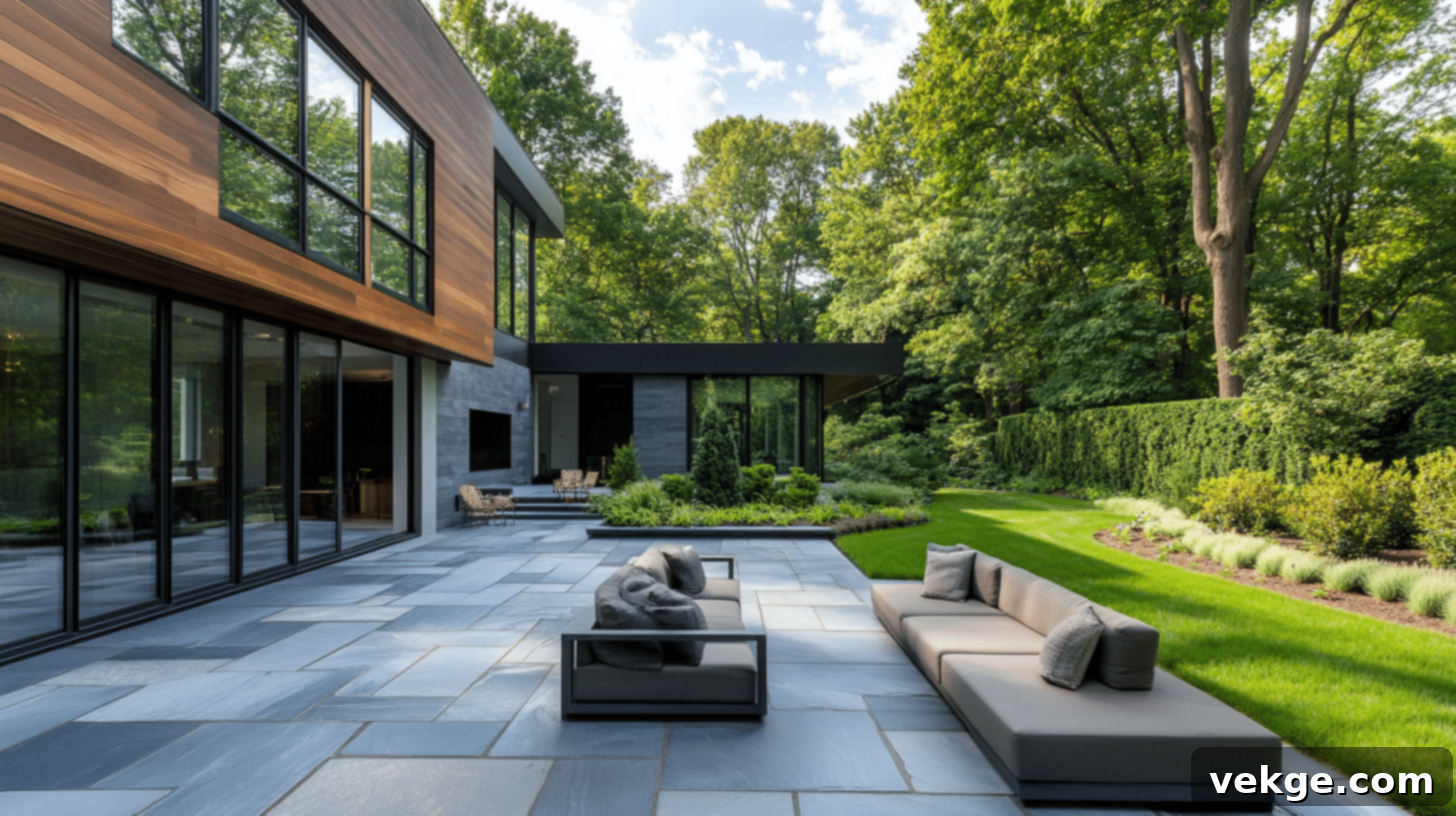Bluestone Patios: The Ultimate Guide to Design, Installation, and Lasting Beauty
Bluestone patios have emerged as a premier choice for homeowners aiming to elevate their outdoor living areas. These remarkable additions seamlessly blend natural elegance with exceptional durability, offering a timeless foundation for relaxation and entertainment.
Distinguished by its rich spectrum of colors, ranging from deep blues and grays to subtle greens and browns, and its inherently unique textures, bluestone creates an aesthetically captivating surface. This natural stone harmonizes effortlessly with diverse landscape designs, enhancing the visual appeal of any garden, yard, or exterior space.
Whether you envision a tranquil backyard sanctuary for quiet reflection or an expansive, vibrant area perfect for hosting gatherings, bluestone patios provide unparalleled versatility. Their enduring charm ensures they remain stylish for decades, making them a wise and valuable investment that significantly boosts your home’s curb appeal and functionality.
This comprehensive guide will equip you with all the essential knowledge regarding bluestone patios. We’ll delve into critical aspects, from selecting the ideal stone and navigating the installation process to mastering long-term maintenance. Regardless of whether you’re embarking on a brand-new patio project or planning to revitalize an existing one, you’ll uncover invaluable insights and practical advice to help you make well-informed decisions and achieve your dream outdoor space.
What Is Bluestone? Unveiling this Natural Wonder for Your Patio
Bluestone is a distinguished natural stone widely utilized in a variety of outdoor landscaping applications, most notably for crafting exquisite patios. Geologically, it is a type of sedimentary rock, typically recognized as a dense sandstone or, less commonly, limestone. Its formation is a testament to geological time, occurring over millions of years as layers of sediment, such as quartz, feldspar, and mica, are compressed under immense pressure and heat.
The stone acquires its iconic name from its predominant blue-gray coloration, which can vary significantly depending on the minerals present during its formation. Hues can range from deep, profound blues to light, ethereal grays, and even subtle greenish-gray tones, providing a rich palette that complements natural environments beautifully. These variations, along with natural clefts and fissures, contribute to its unique character.
High-quality bluestone is primarily quarried in specific regions of the northeastern United States, with New York and Pennsylvania being particularly renowned for their abundant deposits. Pennsylvania bluestone, in particular, is celebrated for its exceptional density, frost resistance, and a broad “full-range” color spectrum, making it a highly sought-after material for durable and visually stunning outdoor surfaces.
Different Types of Bluestone for Every Patio Vision
Bluestone comes in various forms and finishes, each offering a distinct aesthetic and tactile experience. The choice of type often depends on the desired look, the intended use of the patio, and budget considerations. Below is a detailed comparison of common bluestone types, their characteristics, and typical costs.
| Type | Surface Finish | Shape | Appearance | Cost (per sq. ft.) |
|---|---|---|---|---|
| Thermal Bluestone | Smooth, consistent, slightly textured | Uniform squares/rectangles | Sleek, flat, and evenly textured, often with a subtle bluish hue. Ideal for modern, refined spaces. | $10 – $20 |
| Natural Cleft Bluestone | Rough, textured, naturally uneven | Irregular shapes or rectangles | Authentic, rustic look with significant surface variations. Mimics naturally split stone, perfect for a traditional or rugged aesthetic. | $8 – $18 |
| Irregular Bluestone (Flagstone) | Natural, textured, varied | Random, organic, irregular shapes | Free-form and organic, designed to be fitted together like a puzzle. Best for natural, cottage-style patios and pathways. | $6 – $15 |
| Cut Bluestone | Smooth or slightly textured, precise | Uniform squares/rectangles, often precise dimensions | Clean, sharp lines and consistent sizing. Can be thermal or natural cleft, but always cut to specific dimensions for a tailored look. | $12 – $25 |
| Tumbled Bluestone | Soft, weathered, rounded edges | Softened edges, uniform shapes (often squares/rectangles) | Aged, antique appearance achieved through tumbling. Edges are softened, giving a historic or European courtyard feel. | $15 – $30 |
| Pennsylvania Bluestone | Varies: smooth (thermal) or textured (natural cleft) | Full-range or blue-gray colors, often cut or irregular | Offers a wide spectrum of natural earth tones (full-range) or classic blue-gray. Known for exceptional density and durability. | $10 – $20 |
Looking to source beautiful paving stones similar to those listed above? Explore a curated selection of outdoor pavers and tiles that offer the same durability and style flexibility, perfect for any bluestone-inspired patio design.
Advantages and Drawbacks of Choosing Bluestone for Your Patio
Bluestone patios are a celebrated choice for outdoor spaces, widely praised for their inherent beauty and robustness. However, like any building material, bluestone presents a unique set of pros and cons. Understanding these can help you determine if it’s the ideal material for your specific outdoor project.
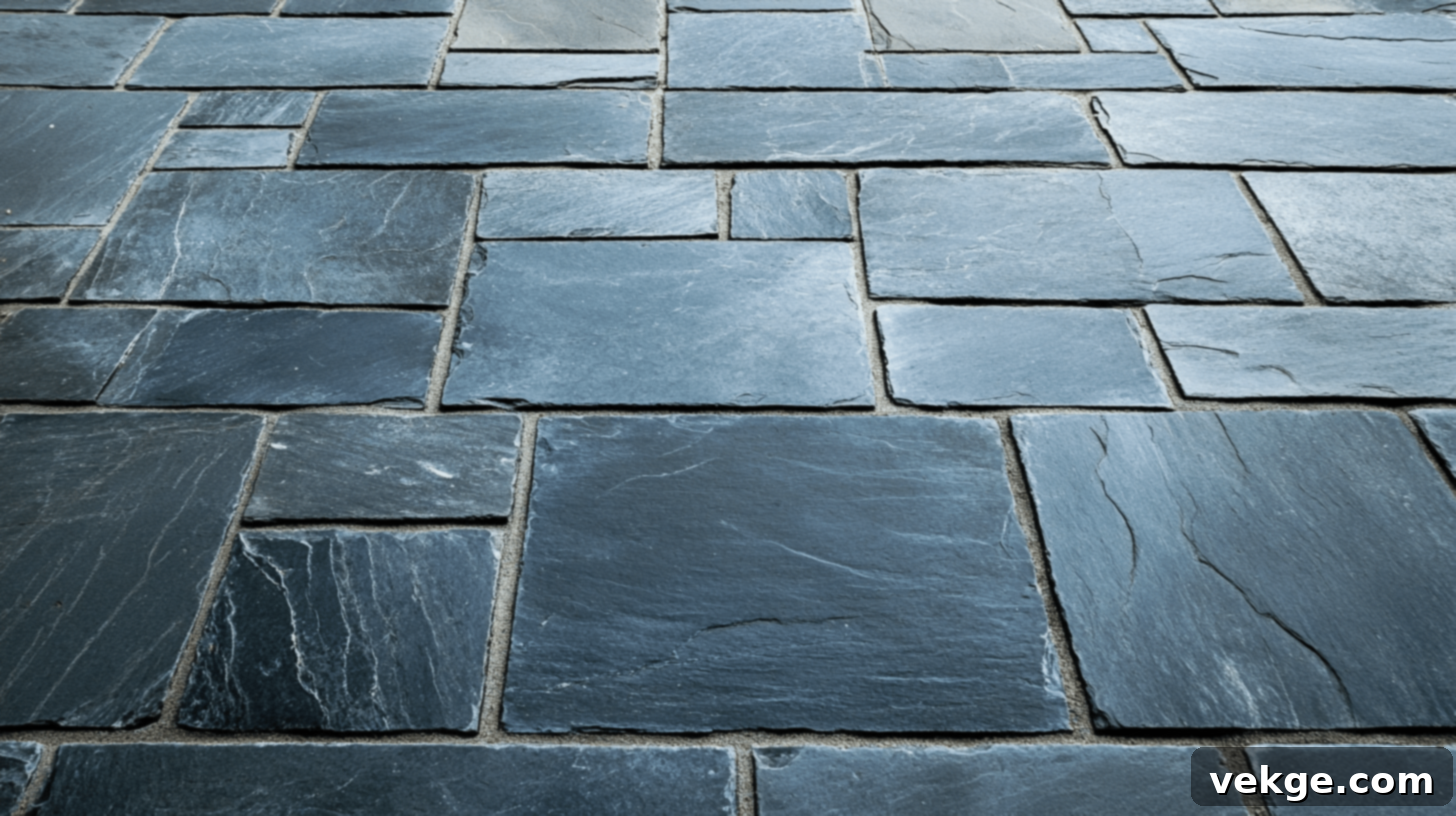
Advantages of Bluestone Patios: Why It Stands Out
- Exceptional Durability: Bluestone is a remarkably resilient natural stone. Its dense composition allows it to withstand significant foot traffic, harsh weather conditions, and general wear and tear over many decades. It is highly resistant to cracking, chipping, and breaking, making it an excellent, long-lasting choice for patios in diverse climates, including those with freezing temperatures.
- Unparalleled Natural Beauty: The captivating array of natural colors—from deep blues and grays to greens and browns—combined with its distinctive textures, creates an attractive, organic, and sophisticated look for any outdoor setting. Each slab is unique, ensuring your patio has a bespoke, natural aesthetic that evolves gracefully with time.
- Design Versatility: With various shapes, sizes, and finishes (such as thermal, natural cleft, and irregular flagstone), bluestone offers immense design flexibility. This adaptability makes it suitable for creating anything from formal, precisely patterned patios to informal, rustic retreats, complementing both traditional and contemporary architectural styles.
- Excellent Slip Resistance: Particularly with natural cleft or thermal finishes, bluestone’s textured surface provides superior grip. This inherent slip resistance makes it a safe and practical material for areas prone to moisture, such as pool decks, walkways, and patios exposed to rain or irrigation.
- Superior Weather Resistance: Bluestone is renowned for its frost resistance and ability to endure extreme temperature fluctuations. Its low rate of expansion and contraction helps prevent the cracking and spalling often seen in less resilient materials during freeze-thaw cycles, ensuring its integrity in colder climates.
- Relatively Low Maintenance: Once properly installed and sealed, bluestone patios require relatively minimal upkeep. Routine tasks like sweeping away leaves and debris, coupled with occasional power washing on a low setting, are usually sufficient to keep the patio clean and well-maintained, preserving its beauty for years.
Drawbacks of Bluestone Patios: Considerations Before Investing
- Higher Initial Cost: Bluestone is generally more expensive than many other common patio materials like poured concrete, gravel, or even some types of manufactured pavers. The cost encompasses not only the stone itself but also the specialized labor required for professional installation, which can make it a significant initial investment.
- Heat Retention (for darker shades): While many bluestone varieties remain relatively cool, darker-colored bluestone can absorb and retain a considerable amount of heat when exposed to direct, intense sunlight. This can make the surface uncomfortably hot to walk on barefoot during peak summer days.
- Potential for Color Fading: Over extended periods, the vibrant blue-gray and full-range tones of bluestone can subtly fade due to continuous exposure to UV rays and various weather elements. While sealing the stone regularly can help protect its color and enhance its longevity, some degree of natural weathering and patina development is to be expected.
- Porosity and Staining Risk: Bluestone is a naturally porous material, meaning it can absorb water and other liquids if not adequately sealed. This porosity makes it susceptible to staining from spilled food, drinks, oils, or even organic matter like leaves. Proper sealing is crucial, especially for patios used for dining or located near pools, to prevent deep-set stains.
- Surface Irregularities (Natural Cleft): While highly valued for its rustic charm, natural cleft bluestone inherently features an uneven surface. This characteristic might not be ideal for all applications, particularly where perfect stability for outdoor furniture is required, or for areas needing easy accessibility for strollers or wheelchairs.
Bluestone vs. Other Popular Patio Materials: A Comprehensive Comparison
Choosing the right material for your patio is a critical decision that impacts its aesthetics, durability, and long-term enjoyment. While bluestone offers many advantages, it’s helpful to see how it stacks up against other common patio materials. This comparison highlights key features to help you make an informed choice for your outdoor living space.
| Feature | Bluestone | Concrete | Pavers (Concrete/Brick) | Flagstone (Other Types) | Brick | Gravel |
|---|---|---|---|---|---|---|
| Durability | High (Resistant to freeze-thaw) | High (Can crack over time) | Very High (Interlocking strength) | High (Natural, dense stone) | Moderate to High (Long-lasting, but can chip) | Moderate (Can shift, needs replenishment) |
| Appearance | Natural, rustic to refined, unique colors | Plain, customizable with stamps/stains | Uniform, versatile patterns, many colors | Natural, irregular, organic look (e.g., slate, sandstone) | Classic, traditional, charming | Rustic, casual, natural filler |
| Color Options | Limited (blue-gray, full-range earth tones) | Wide range (pigments, stains) | Wide range of colors and textures | Earth tones, natural variations | Red, brown, terra cotta, earth tones | Neutral (grays, browns, whites) |
| Maintenance | Low to Moderate (Sealing, cleaning) | Low (Sealing for stains, occasional cleaning) | Low to Moderate (Weed control, occasional cleaning) | Moderate (Weed control, occasional cleaning, sealing) | Low to Moderate (Weed control, cleaning) | Low (Weed control, raking, replenishment) |
| Slip Resistance | High (Especially natural cleft/thermal) | Low to Moderate (Can be slippery when wet, can be textured) | High (Textured surfaces available) | High (Natural textured surfaces) | Moderate (Can be smooth) | High (Loose aggregate provides grip) |
| Lifespan | 50-100+ years | 25-50 years (with proper care) | 50-100+ years | 50-100+ years | 100+ years | 10-20 years (with regular replenishment) |
| Weather Resistance | Excellent (Frost-resistant, handles extreme temps) | Good (Can crack in freeze-thaw without proper rebar) | Excellent (Designed for freeze-thaw) | Excellent (Natural stone properties) | Excellent (Durable in various climates) | Moderate (Can erode, displace) |
| Sustainability | Natural, eco-friendly, locally sourced (in some regions) | Artificial, high carbon footprint in production | Varies based on material, some recycled content | Natural, eco-friendly, minimal processing | Natural (clay), eco-friendly | Natural, eco-friendly |
| Installation Difficulty | Moderate (Requires precision, heavy lifting) | Easy (For basic slab), Moderate (For stamped/colored) | Easy to Moderate (DIY possible) | Moderate to High (Fitting irregular pieces) | Easy (Laying pattern) | Very Easy (Spreading, leveling) |
| Cost (per sq. ft.) | $10-$30 | $5-$15 | $8-$25 | $15-$30 | $8-$20 | $1-$5 |
As this comparison illustrates, bluestone excels in durability, natural beauty, and weather resistance, positioning it as a premium, long-term investment. While its initial cost and installation might be higher than some alternatives, its longevity and aesthetic appeal often justify the expense for those seeking a distinguished outdoor space.
Step-By-Step Guide to Installing a Beautiful Bluestone Patio
Installing a bluestone patio is a rewarding project that, with careful planning and execution, can significantly enhance your outdoor living area. This guide provides a detailed walkthrough of the process, ensuring a durable and aesthetically pleasing result. While professional installation is always an option, a DIY approach is feasible for those with moderate experience and the right tools.
Tools and Materials Table for Bluestone Patio Installation
Before you begin, gather all necessary tools and materials. Having everything on hand will ensure a smooth and efficient installation process.
| Tool/Material | Purpose |
|---|---|
| Bluestone Slabs | The primary material that forms the patio’s surface. Choose your desired type and finish. |
| Pack Material (LOM – Lift-Off Material, or Crushed Stone) | A granular, well-draining base material (e.g., 3/4″ crushed stone or gravel) placed under the patio to provide stability, prevent water retention, and mitigate frost heaving. |
| Stone Dust (or Fine Crushed Stone) | A fine aggregate material that creates a smooth, permeable, and firm setting bed for the bluestone. |
| Portland Cement | Mixed with stone dust to create a stiff, durable, and semi-permeable setting bed, enhancing stability and preventing shifting. |
| Chalk Reel | Essential for accurately marking out straight lines and defining the patio’s layout and perimeter. |
| Rubber Mallet | Used to gently tap and level the bluestone slabs into place, ensuring a secure and even surface without damaging the stone. |
| Plate Compactor | A heavy-duty rental tool crucial for thoroughly compacting the pack material base, creating a solid, stable, and unyielding foundation. |
| 4-Foot Level (or longer) | Indispensable for meticulously checking that each bluestone slab is perfectly level and maintaining the desired slope for drainage. |
| Pointed Trowel | Used for precisely spreading and smoothing the cement setting base under each bluestone slab. |
| Wheelbarrow | A robust tool for efficiently mixing the stone dust and cement mixture, and for transporting materials around the site. |
| Shovel (Flat and Pointed) | For digging, spreading, and moving the base materials and cement mixture. |
| Rake | Used to evenly spread and smooth out the pack material and stone dust layers before laying the bluestone. |
| Mason’s String Line and Stakes | For establishing precise grades and lines, especially important for ensuring consistent slope. |
| Safety Glasses and Gloves | Essential personal protective equipment for all phases of installation. |
Step 1: Meticulously Prepare the Base Foundation
Begin by excavating the patio area to the required depth, typically 6-8 inches, ensuring proper drainage slope (about 1/4 inch per foot away from any structures). Spread a layer of pack material (LOM or 3/4″ crushed stone) evenly across the entire excavated area. This layer should be at least 4-6 inches thick once compacted. Use a sturdy rake to distribute the material smoothly and achieve a consistent grade. Next, using a robust plate compactor, thoroughly compact this base material. Make multiple passes in different directions to ensure a rock-solid, stable foundation that will prevent settling and movement of your bluestone patio over time.
Step 2: Precisely Mix the Cement Setting Base
In your wheelbarrow, combine seven parts of stone dust with one part of Portland cement. This ratio provides excellent stability and setting properties. Gradually add just enough water to the dry mixture while mixing thoroughly with a shovel. The goal is to achieve a “damp sand” consistency—the mixture should hold its shape when squeezed but not be wet or muddy. This slightly damp, workable mixture will serve as the firm yet slightly flexible bed upon which your bluestone slabs will rest, preventing future shifting.
Step 3: Evenly Spread the Cement Mixture
Work in small sections, typically enough area to set three to four bluestone slabs at a time. Using a pointed trowel, carefully apply a consistent layer of the cement mixture over the prepared pack material. Aim for an even layer approximately 1-2 inches thick. Smooth the mixture meticulously to create a flat, consistent surface, but do not compress it at this stage. This even layer is crucial for ensuring uniform support and levelness for your bluestone.
Step 4: Lay and Secure the Bluestone Slabs
Carefully place your chosen bluestone slabs onto the freshly spread cement base. Begin at one edge of your patio area, working your way across. Using a rubber mallet, gently but firmly tap each bluestone slab into place. Tap along the entire surface of the stone to ensure it settles securely and evenly into the cement mixture. Check that there is no rocking or unstable movement. Maintain consistent joint spacing (typically 1/2 to 1 inch) between stones, using spacers if necessary, for a professional finish.
Step 5: Ensure Proper Slope and Levelness
As you continue to lay each stone, it is absolutely critical to maintain a slight, consistent slope across the patio surface, typically 1/4 inch per foot, directing water away from your house or any other structures. Frequently use a 4-foot level (or longer) to check the levelness of individual stones and the overall slope of the patio. Place the level across adjacent stones and in multiple directions. Adjust stones as needed by adding or removing small amounts of the cement mixture beneath them, tapping them back into place until the desired level and slope are achieved. This step is vital for effective drainage and preventing water pooling.
Step 6: Jointing and Curing (Optional but Recommended for Durability)
Once all bluestone slabs are laid and settled, allow the cement setting base to cure for at least 24-48 hours before proceeding. For a more robust and finished patio, sweep polymeric sand or a mortar mixture into the joints between the stones. If using polymeric sand, follow the manufacturer’s instructions carefully for sweeping and misting with water to activate the binding agents. If using traditional mortar, apply it with a pointing trowel and clean excess from the stone surface before it sets. This jointing process helps lock the stones in place, prevents weed growth, and enhances the patio’s overall stability and appearance.
Different Styles of Bluestone Patios: Crafting Your Outdoor Oasis
Bluestone patios offer immense design flexibility, allowing homeowners to create diverse aesthetics from ruggedly natural to exquisitely formal. The final look of your patio largely depends on the cut, shape, and pattern in which the bluestone is laid. Here, we explore some of the most popular bluestone patio styles, providing inspiration for your outdoor space.
1. Random Irregular (Flagstone) Style
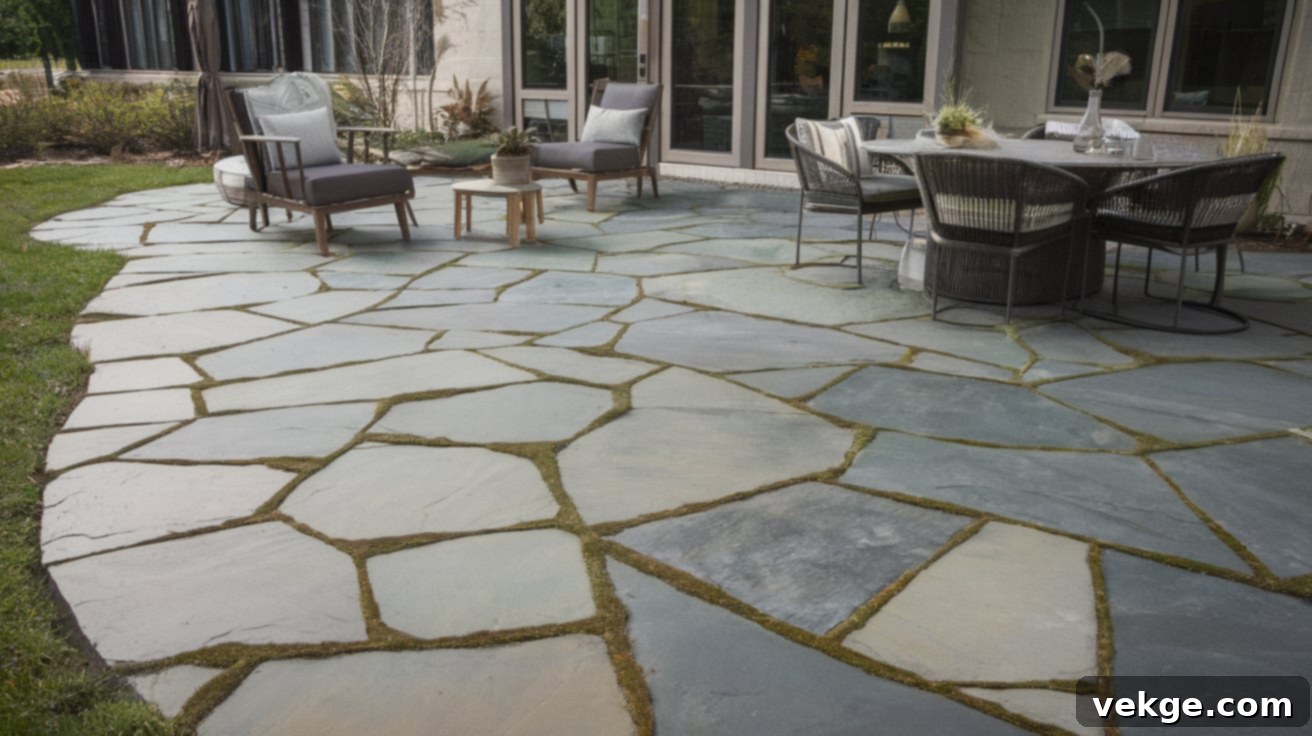
This style utilizes bluestone pieces cut into various irregular and organic shapes, creating a captivating, natural, and seemingly random mosaic when laid out. The stones are carefully fitted together like a jigsaw puzzle, with varying sizes and contours. The natural cleft finish is often chosen for this style, emphasizing its rustic appeal.
- Best For: Achieving a rustic, natural, or cottage-style aesthetic; pathways, informal garden patios, or areas seeking an organic, unmanicured charm.
- Design Tip: Keep joint lines relatively narrow and fill with polymeric sand or fine gravel for a softer look.
2. Geometric/Dimensional Style

In contrast to the irregular style, this approach employs bluestone precisely cut into uniform geometric shapes, typically squares and rectangles of consistent sizes. These stones are arranged in clean, structured patterns such as a grid, running bond, or stack bond. Thermal bluestone is often preferred for its smooth, consistent finish that highlights the precise cuts and orderly layout.
- Best For: Contemporary, modern, minimalist, or formal landscape designs where clean lines and a structured appearance are desired.
- Design Tip: Use wide, contrasting mortar joints for a bold statement or tight, inconspicuous joints for a seamless, sleek look.
3. Herringbone Pattern
The herringbone pattern is a classic and visually dynamic layout created by arranging rectangular bluestone pavers at 45-degree angles to form a distinctive V-shaped, zigzag pattern. This intricate design adds a sense of movement and sophistication to the patio surface, making it a focal point.
- Best For: Traditional, formal, European-inspired, or eclectic outdoor spaces that benefit from a visually rich and engaging pattern.
- Design Tip: Ensure precise cuts and consistent jointing to maximize the impact of this elegant pattern.
4. French Pattern (Ashlar Pattern)

Also known as an Ashlar pattern, the French pattern involves a sophisticated combination of squares and rectangles of varying sizes that are arranged in a repeated, modular layout. This creates an asymmetrical yet highly structured and visually interesting design that evokes a sense of Old-World charm and grandeur.
- Best For: Traditional, Mediterranean, or European-inspired patios and courtyards that require a blend of formality and intricate detail.
- Design Tip: Use a full-range bluestone to highlight the diverse sizes and natural variations within the pattern.
5. Circular or Radial Pattern
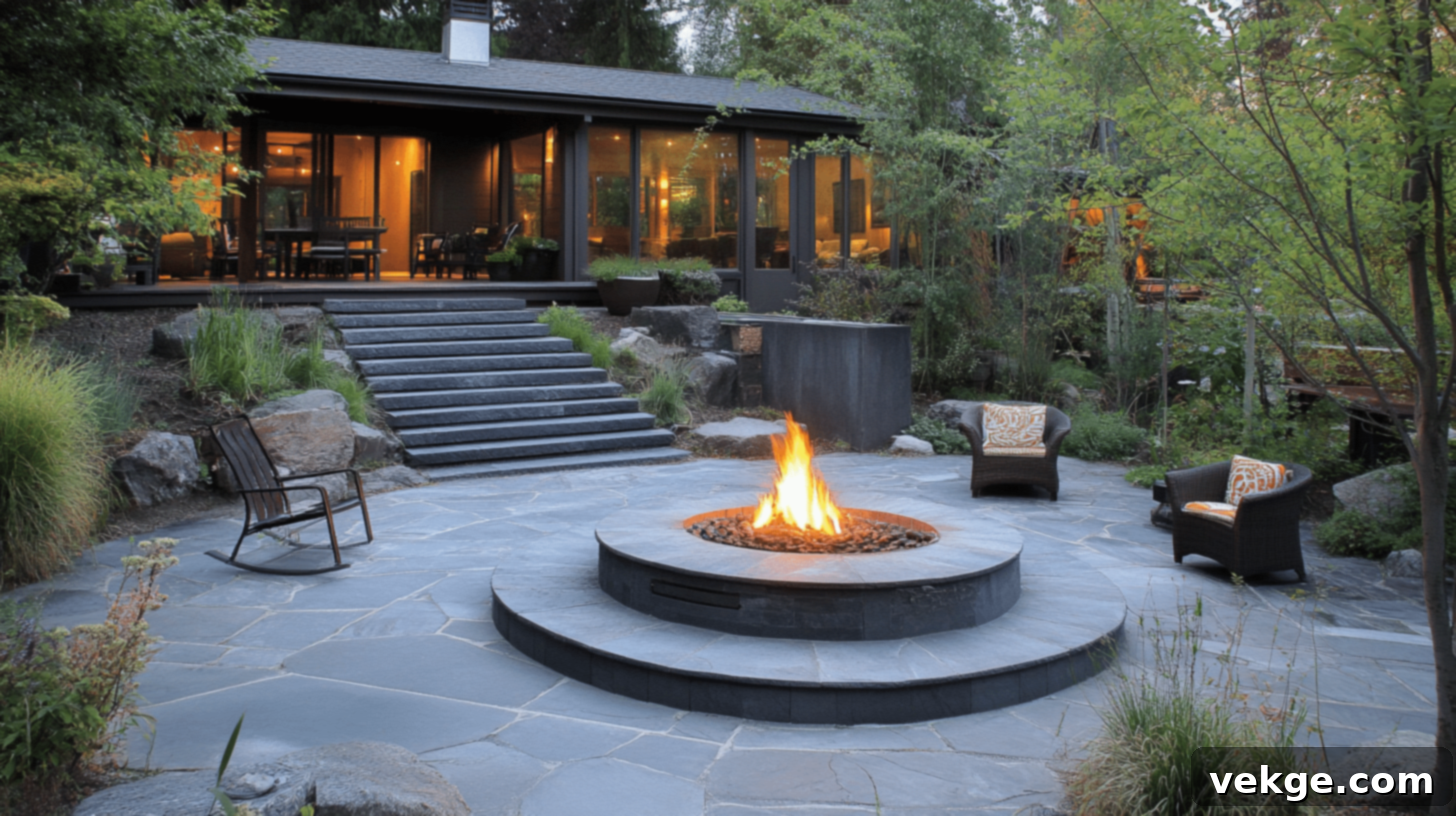
This unique style arranges bluestone in concentric circles or radial designs, typically centered around a specific focal point. This could be a fire pit, an outdoor dining area, a fountain, or a statue. The radiating lines draw the eye towards the center, creating a powerful visual anchor for the space.
- Best For: Creating central gathering areas, defining specific zones within a larger patio, or highlighting a focal point in your landscape.
- Design Tip: This pattern often requires precise stone cutting, so it’s often best handled by experienced installers.
6. Stepping Stone Style
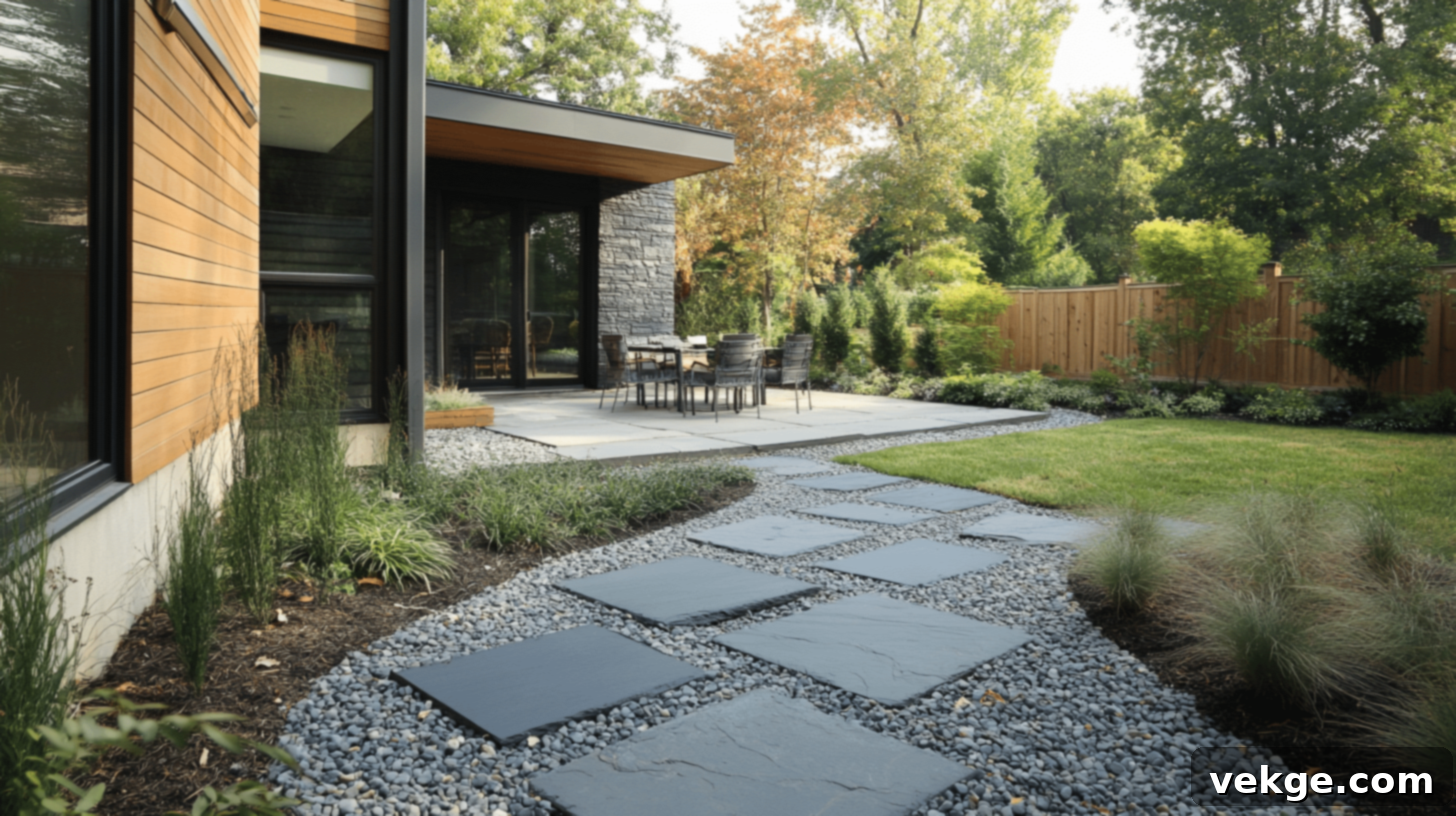
While often used for walkways, the stepping stone style can be adapted for a more informal patio design. Large, individual bluestone slabs, typically irregular in shape, are strategically placed with generous gaps between them. These gaps are then filled with other materials like gravel, grass, or mulch, creating a soft, permeable surface.
- Best For: Garden paths, informal patios that blend seamlessly with natural surroundings, or transitional spaces between different outdoor zones.
- Design Tip: Ensure stones are stable and level to prevent tripping hazards. The choice of infill material significantly impacts the overall look.
7. Mixed Materials Style
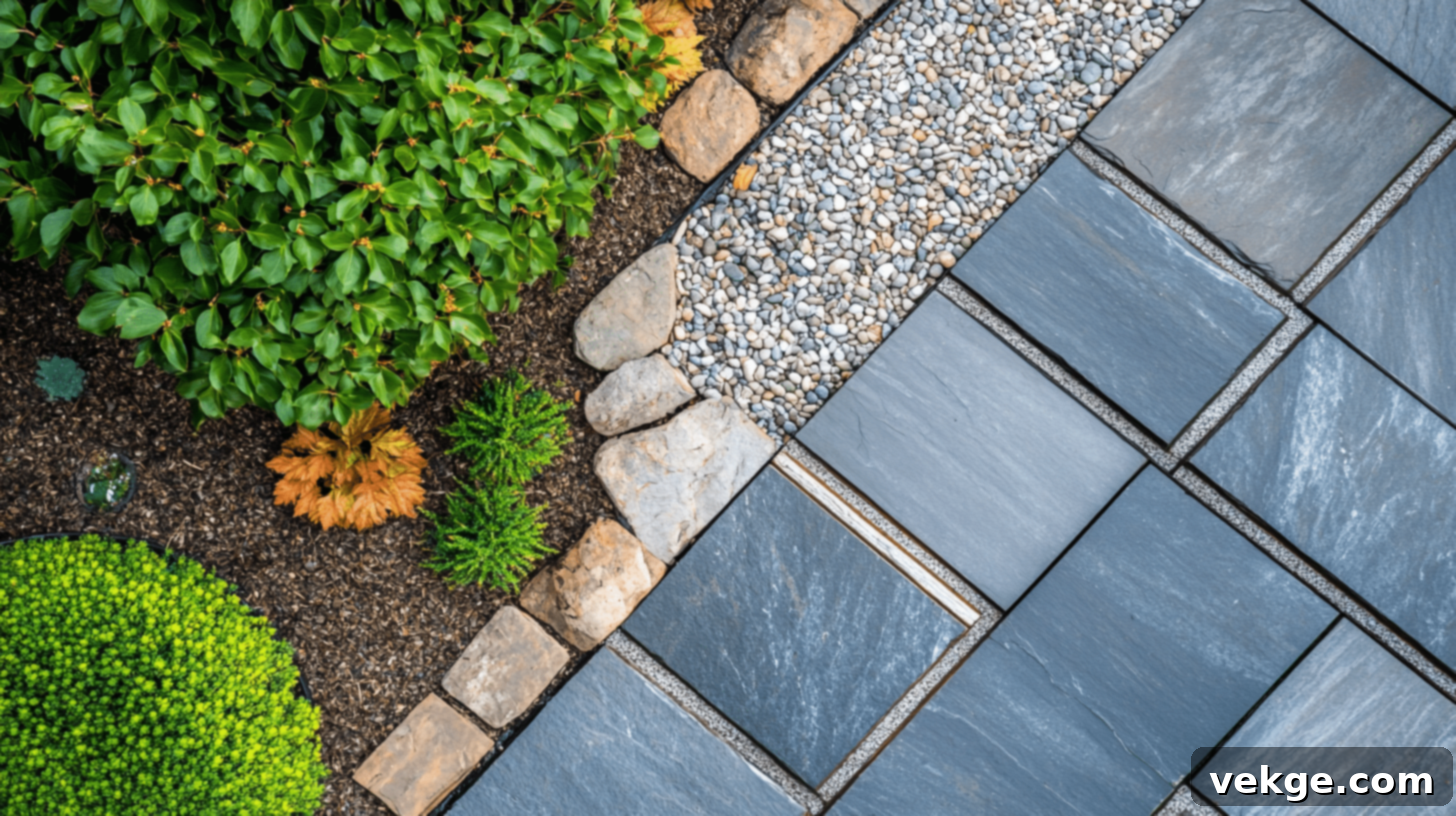
This highly creative style combines bluestone with other complementary outdoor materials, such as brick, gravel, concrete, or even wood. Bluestone can serve as the primary paving material, with accents, borders, or pathways made from contrasting materials, adding visual interest, texture, and color variations. This style allows for truly custom and unique designs.
- Best For: Eclectic, custom-designed patios that reflect unique personal tastes or blend with existing architectural elements; defining different functional zones within a large patio.
- Design Tip: Choose materials that complement bluestone’s natural tones and ensure proper transitions between different surfaces for durability and aesthetics.
Essential Cleaning and Care Tips for Your Bluestone Patio: Maintaining its Pristine Beauty
While bluestone is renowned for its durability and low maintenance, consistent care is key to preserving its natural beauty and extending its lifespan. Adhering to a regular cleaning and maintenance regimen will protect your investment and ensure your patio remains a stunning feature of your outdoor space for decades.
- Regular Cleaning for Daily Shine: Make it a habit to sweep your bluestone patio weekly to remove loose dirt, leaves, and other debris. This prevents organic matter from breaking down and staining the stone. For routine cleaning, prepare a solution of mild, pH-neutral soap (like dish soap) mixed with warm water. Use a stiff-bristled brush or a mop to scrub the surface gently, then rinse thoroughly with a garden hose. Once or twice a year, consider using a pressure washer on a *low-pressure setting* (typically below 1200 PSI) to deep clean the stone, being careful not to damage the surface or wash out jointing material.
- Effective Stain Management and Prevention: For stubborn stains, such as oil, grease, or organic marks, create a paste using baking soda and a small amount of water. Apply this paste directly to the stain, let it sit for about 15-30 minutes to allow it to absorb the stain, then gently scrub with a soft brush and rinse thoroughly. To proactively prevent future staining and enhance the stone’s resistance to moisture, apply a high-quality, penetrating stone sealer every 2-3 years. Always follow the manufacturer’s specific instructions for application and curing times to ensure optimal protection.
- Strategic Seasonal Care: During winter months, especially in cold climates, *avoid* using harsh de-icing salts (like rock salt or calcium chloride) on your bluestone patio, as these chemicals can corrode the stone’s surface and damage the mortar joints. Instead, use clean sand or a non-corrosive, bluestone-safe de-icing product for traction on icy areas. In warmer seasons, vigilantly remove any weeds, moss, or algae that begin to grow between the stones or on the surface. These can cause discoloration, retain moisture, and potentially compromise the patio’s structural integrity over time.
- Proactive Structural Maintenance: To prevent scratches and abrasions, always place felt pads or furniture glides under the legs of heavy outdoor furniture. Periodically inspect the mortar or polymeric sand in the joints between your bluestone slabs. If you notice any loose, cracked, or missing jointing material, promptly repair it to prevent water infiltration, weed growth, and shifting of the stones. Consider scheduling a professional inspection of your bluestone patio every few years. Experts can identify potential issues early, such as drainage problems or subtle shifts in the foundation, and recommend timely repairs to avoid more extensive damage.
By diligently following these comprehensive maintenance and cleaning tips, you can confidently preserve the inherent beauty, structural integrity, and long-term appeal of your bluestone patio for many years to come. Remember, consistent and thoughtful care is the cornerstone of maintaining the pristine condition and longevity of this exquisite outdoor feature.
Conclusion: Embrace the Enduring Elegance of Bluestone Patios
Bluestone patios stand as a testament to the perfect marriage of natural beauty, exceptional durability, and unparalleled versatility, offering an exquisite upgrade to any outdoor space. From their captivating natural charm and rich color variations to the myriad of design options, bluestone has the power to transform an ordinary backyard into an extraordinary oasis.
While the initial investment for a bluestone patio may be higher compared to some alternative materials, its impressive longevity, minimal maintenance requirements, and enduring aesthetic appeal make it a remarkably smart and valuable investment. It’s a material that truly pays dividends over time, adding significant value and enjoyment to your home. Whether your taste leans towards classic elegance or contemporary minimalism, there is a bluestone patio design perfectly suited to your vision and lifestyle.
As you embark on planning your next outdoor project, we encourage you to consider the timeless elegance and inherent advantages of bluestone. It is a natural stone celebrated for its ability to withstand harsh weather conditions, age gracefully with a beautiful patina, and offer an environmentally friendly choice for sustainable landscaping. A bluestone patio is more than just a hardscape; it’s an invitation to embrace outdoor living at its finest, promising decades of beauty and function.
Ready to transform your outdoor living area into a stunning, resilient, and inviting retreat? Your perfect outdoor haven is closer than you think. Contact a local, reputable landscaper today for a personalized quote and expert guidance tailored to your specific needs. Alternatively, explore our free bluestone patio design guide to spark your imagination and delve deeper into the endless possibilities. The enduring charm and sophistication of bluestone await!
Frequently Asked Questions About Bluestone Patios
Is Bluestone Suitable for Cold Climates and Freeze-Thaw Cycles?
Yes, bluestone is exceptionally well-suited for cold climates and areas experiencing frequent freeze-thaw cycles. Its dense, non-porous (or low-porosity when sealed) nature makes it highly resistant to cracking and spalling that can affect less durable materials. The stone’s minimal water absorption and expansion/contraction rate ensure its structural integrity is maintained even through harsh winters, making it a reliable choice for long-term performance in cold regions.
How Long Can a Well-Maintained Bluestone Patio Be Expected to Last?
A properly installed and consistently maintained bluestone patio boasts an impressive lifespan, typically lasting 50 years or even more. Its natural durability means it can withstand decades of foot traffic, weather exposure, and general wear. Regular cleaning, timely sealing, and prompt repairs of any loose joints or damaged stones can significantly extend its longevity, often allowing it to outlast the home itself.
Can Bluestone Be Safely Used Around Swimming Pools and Wet Areas?
Absolutely, bluestone is an excellent choice for pool surrounds and other wet areas. Many bluestone finishes, particularly natural cleft or thermal (flamed) surfaces, provide superior natural traction, greatly reducing the risk of slips and falls when wet. For added protection against pool chemicals and staining from water, it is highly recommended to apply a high-quality penetrating sealer. This enhances its resistance to moisture, chlorine, and potential organic growth.
How Does Bluestone Age and What Changes Can I Expect Over Time?
Bluestone ages remarkably gracefully, developing a subtle and desirable patina over time. While some types might experience a slight, natural softening or fading of their original vibrant colors due to prolonged exposure to UV rays and environmental elements, this process typically adds character and a more weathered, antique appearance to the stone. Consistent cleaning and periodic sealing play a crucial role in maintaining its initial beauty and preventing excessive discoloration, ensuring it remains an attractive feature for years.
Is Bluestone Considered an Environmentally Friendly Material?
Yes, bluestone is widely considered an environmentally friendly and sustainable material. As a natural stone, it requires minimal processing compared to manufactured paving options, reducing its overall carbon footprint. It is a highly durable and long-lasting material, which means less frequent replacement and reduced waste. Furthermore, bluestone is recyclable and does not leach harmful chemicals or pollutants into the environment, making it a responsible choice for eco-conscious homeowners and sustainable landscaping projects.
